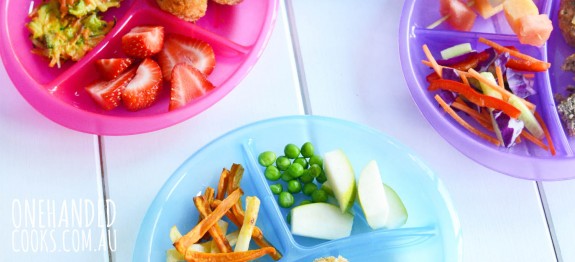The Tasting Plate: Why We Love The Tasting Plate
You will find the full tasting plate article and recipes in our Launch Magazine. Yep you can buy online NOW until stocks last.
Read first: introducing the tasting plate
Read next: Parent-led weaning Vs baby-led weaning
Why We Love The Tasting Plate
Builds Trust:
The tasting plate is one way of serving a balanced and nutritional meal in a non-confronting way. Combining bite-sized meal options and variety caters to the natural curiosity of a child. When offering your child a plate of food you should try and include something you know he loves with something new or unfamiliar. By offering food in a relaxed and un-forced way your child will be much more inclined and happy to try it.
Limits Picky Eating:
Most children will go through a phase of fussy eating. This is a natural and healthy wariness of all the new and different foods your child is being offered. Many children will refuse to be spoon fed at some stage and opt for finger foods. The Tasting Plate will provide enough variety and distraction to keep your child happy and feeling in control of his choices rather than turning eating into a stressful and negative experience.
Keeps You In Control:
Little ones just love to feel in control and that they are making their own decisions. With The Tasting Plate, you choose what foods go on the plate and your child chooses what and how much of it to eat. If all options on the plate are a healthy choice for your toddler then you can have peace of mind regardless of how much and what tastes they chose to eat.
Encourages Family Food acceptance:
The Tasting Plate will encourage you to incorporate your own family meals into your child’s meal plan. This will allow your child to develop a taste for the food your family usually eats. The transition from baby food to family food should be a smooth process of changing textures, so there’s no need to make separate meals.
Teaches Portion Control:
Children are often over-fed or force-fed even when they genuinely aren’t hungry. By limiting snacking your child is much more inclined to eat a healthy well balanced main meal. The options that The Tasting Plate provides will mean your child is likely to eat ‘something’, which may reduce any mealtime stress and reinforces positive food associations.
Tip: For babies under 12 months of age you might find it best to offer them each food one taste one at a time. Otherwise it may be too overwhelming and the whole plate could be ditched over the side of the highchair.
Finger food safety
As with all finger foods, there are some risks with choking. Those risks can be avoided by taking simple precautions:
- Make sure your baby is sitting upright to eat
- Don’t give your baby whole nuts or hard inappropriate foods
- Cut small fruits in half and remove any pips
- Don’t let anyone except your baby put food into his mouth
- Never leave your baby alone with food
- Partake in a child’s first aid course so you feel more confident in the unlikely event choking does occur.
Even more tasting plate recipes in the ‘Back to school’ magazine issue #2. Buy online Now.
Related posts
Join us on Facebook for other foodie bits and pieces.




























posted by Lindsay on March 25, 2014
I love the idea of the tasting plate but my little boy (18mo) will only eat his preferred food (fruit) and leave the rest. He is usually happy to try the rest (meat, veg etc) but will spit it out or eat one bite. I have more success if I serve it up in courses, I.e. veg first, then meat, then preferred food at the end to fill up. Should I put less of the preferred food on the plate hoping he will be hungrier and eat the rest? P.s thank you for a fantastic site and great ideas